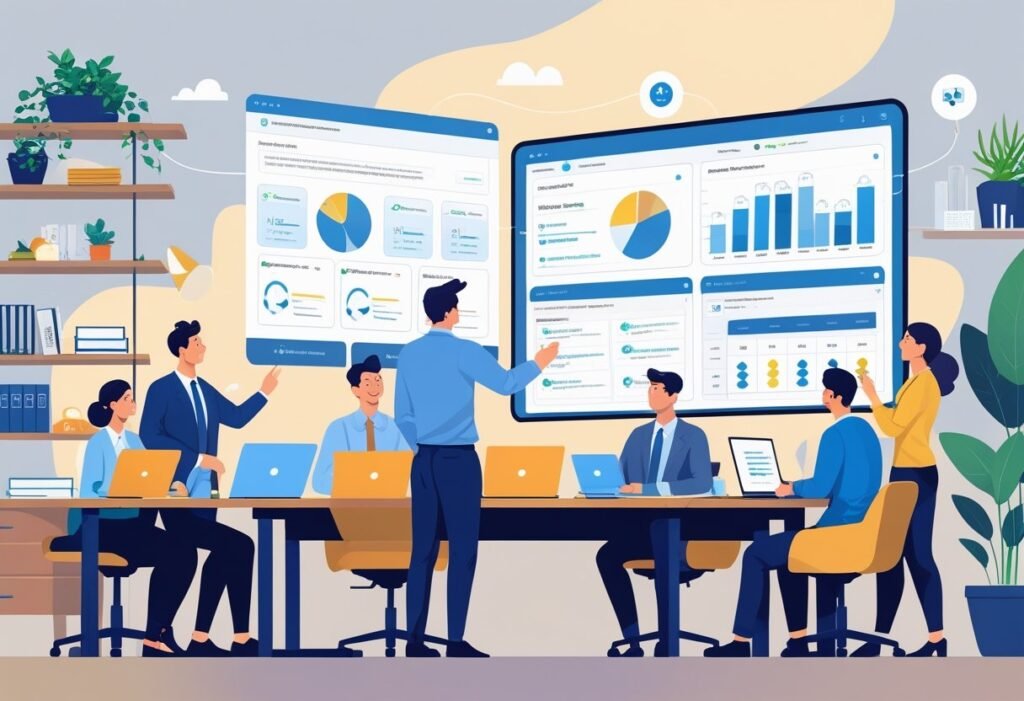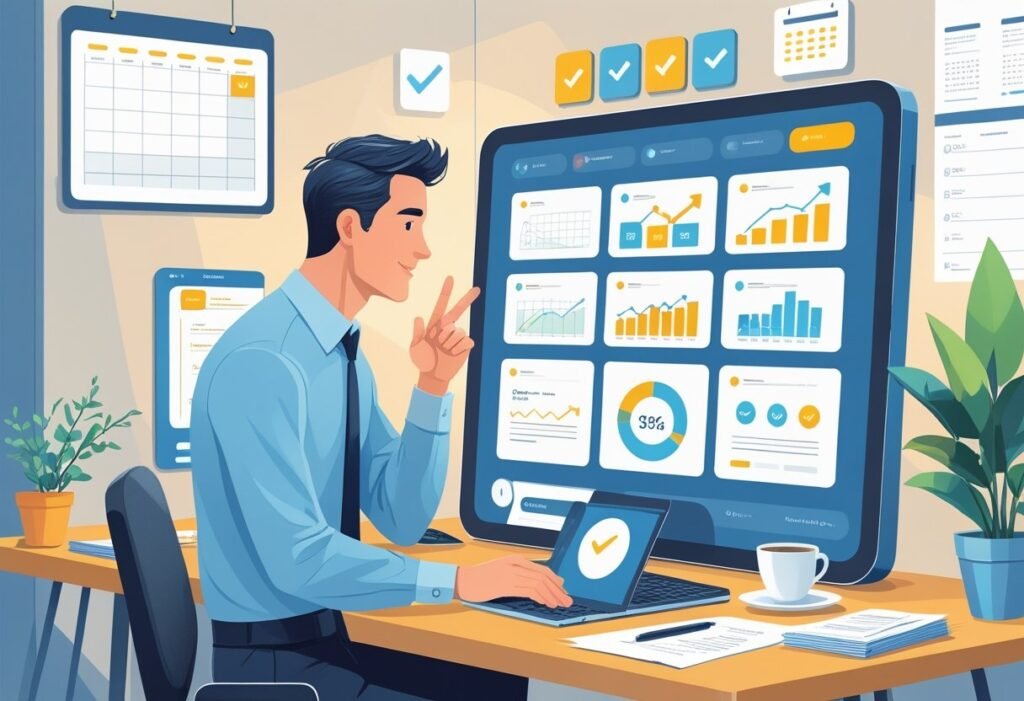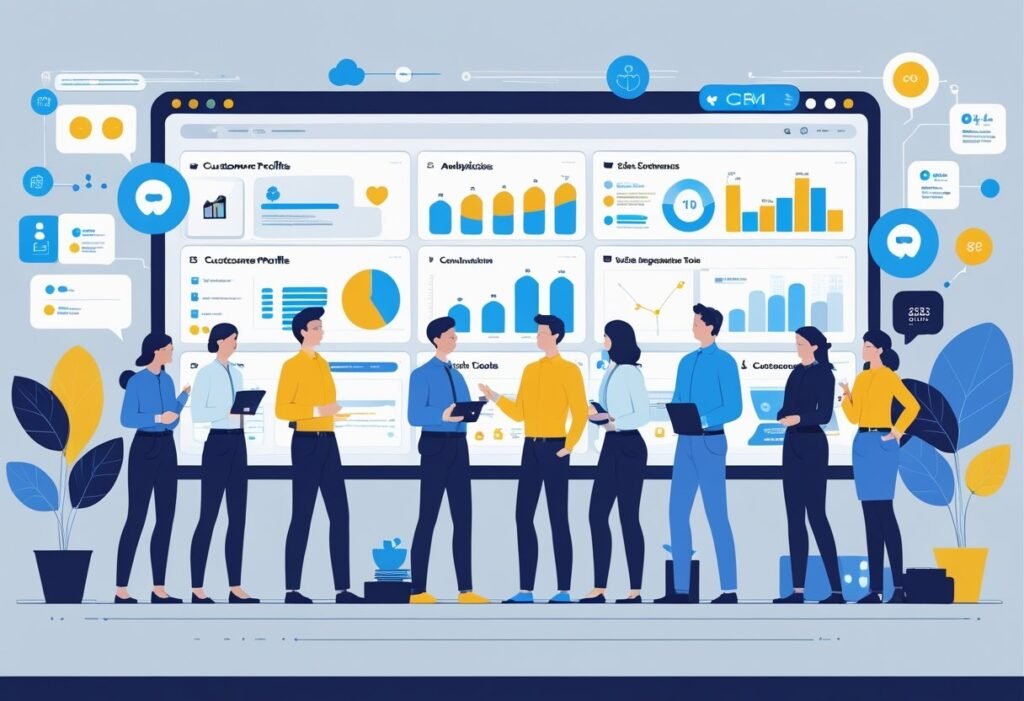Finding the right CRM can make a big difference for a small business, but it isn’t always easy to know where to start. Choosing the right CRM begins with understanding your business’s unique needs and the features that actually help your team organize customer information and manage sales. With so many CRM systems available, it’s important to look past flashy features and focus on tools that will truly fit your day-to-day operations.

Many small businesses need a CRM that is not only easy to use, but also supports both customer communication and data tracking. The right choice can improve the way a team works together, keep customer details in one place, and even help bring in more sales over time. Comparing different options, checking pricing models, and looking for vendors with helpful support can all help make sure a new CRM is a good investment for long-term success.
Key Takeaways
- Identify business needs to choose the right CRM.
- Look for user-friendly features that support daily tasks.
- Pick a vendor and pricing model that works for your budget.
Understanding CRM for Small Businesses

Customer relationship management (CRM) helps small businesses keep up with customer needs, streamline daily operations, and improve how teams work together. Choosing the right CRM software can make it easier to track leads, manage contacts, and use data for smarter decisions.
What Is Customer Relationship Management?
Customer relationship management, or CRM, is a system businesses use to organize and manage customer information, communication, and sales activities. CRM software helps store contact details, track interactions, and schedule important follow-ups.
Many small businesses use CRM solutions to keep all their customer records in one place. This makes it easier to spot sales opportunities, track progress on leads, and make sure customers get quick replies. By keeping their data organized, business owners save time and avoid losing track of important contacts.
A CRM also lets teams see a history of conversations and purchases. This makes it easier for employees to offer better service and answer questions quickly.
Benefits of CRM Solutions for Small Businesses
CRM software gives small businesses several practical advantages. It automates daily tasks like sending emails, setting reminders, and tracking customer interactions. Automation helps staff focus on selling and serving instead of doing repetitive work.
A clear view of customer data means businesses can better understand what their clients need. This leads to improved marketing, smarter sales strategies, and a higher chance of closing deals.
Some CRM tools help with lead generation, deal tracking, and reporting. For example, a CRM for small businesses stores customer info, tracks leads, and helps find new sales opportunities. These solutions also help teams share information and avoid confusion about who is handling what.
CRMs often offer integrations with email, phone, and other tools so that businesses do not have to switch between programs.
How CRM Software Supports Business Growth
CRM software can support business growth by helping owners find patterns and trends in customer data. With strong analytics and reporting features, it becomes easier to spot which types of clients drive the most sales.
Better organization helps businesses respond quickly to sales inquiries or service requests. Fast response times can improve customer satisfaction and boost repeat business.
As businesses grow, CRM systems help scale operations by organizing larger numbers of leads, accounts, and marketing campaigns. Many solutions let users customize features or add new tools as their needs change, making the system flexible for future growth.
CRM platforms also help train new staff since all customer information and task history is easy to find. This keeps teams productive and helps them deliver a consistent level of service.
Key Features to Consider in a CRM System

When selecting a CRM, paying attention to core tools, flexible settings, and how easily the CRM connects with current business programs is vital. Making sure employees can use it easily will also help with day-to-day operations.
Essential CRM Tools and Functionality
A reliable CRM should have features that make customer management easier and support the goals of a small business. These include contact and lead management, sales tracking, and marketing tools. Built-in calendars, reminders, and task lists keep the team organized.
Reporting and analytics features are also key. They allow a business to understand sales trends, customer needs, and team performance. Email integration, call logs, and document storage should be present for efficient communication.
Security features must not be overlooked, as the system will handle sensitive customer data. For more details on what to look for in a CRM, see this U.S. Chamber of Commerce article.
Customization and Automation Options
A good CRM lets users adjust fields, dashboards, and workflows. Customizing the setup means the software will fit the unique tasks of each business.
Automation helps save time by taking care of routine jobs. For example, autoresponders can reply to inquiries, and task automation can move leads between sales stages.
Custom reports allow for tracking the results that matter to the business. Flexible settings make it easier to update the system as the business grows or needs change. More about customization can be found in this guide for small businesses.
Integration Capabilities with Existing Software
CRM systems that connect with accounting tools, email marketing services, and e-commerce platforms help avoid double entry and lost data. Integration also ensures that information flows smoothly between programs.
Look for a CRM that offers plug-ins or built-in connections for software your business already uses. This may include QuickBooks, Mailchimp, Outlook, Shopify, or others.
Support for API access can also help if the business has its own systems. Reliable integrations reduce technical headaches and keep workflow simple. Helpful details about integration are found in this Salesforce CRM comparison.
User Interface and Ease of Use
A CRM will only be successful if the team can use it without confusion. Look for a straightforward dashboard and clear navigation. Key features like contact lists, tasks, and reports should be visible and easy to access.
Onboarding tools and training resources are important, as are options like drag-and-drop organization for data or workflow steps. Short learning curves help the team adopt the CRM faster.
Having a mobile-friendly interface is also a benefit, letting employees work on the go. For more insight, review these tips for choosing a CRM for small business.
Managing Customer Data and Communication

Businesses use CRMs to organize customer information, streamline sales, and improve communication. Effective use of customer data helps maintain strong relationships, track sales leads, and boost productivity.
Contact and Pipeline Management
Contact management is the heart of any CRM. It stores essential details like names, addresses, phone numbers, and communication history for every customer or lead. This information must be easy to access and update.
A well-designed pipeline management tool breaks down each sales opportunity into stages. Each stage shows exactly where a customer or prospect is in the sales journey.
Users can see upcoming tasks, set reminders, and track progress with simple dashboards. This clear structure ensures nothing falls through the cracks. Many solutions also support filtering and segmenting contacts to help teams focus on high-value prospects and prioritize follow-ups. Reliable contact and pipeline tools help salespeople stay organized and close deals faster.
Sales Process and Lead Management
Lead management tools guide users from the first contact to closing a sale. Automation is key: leads can be assigned to the right team member, tracked through custom sales stages, and scored based on set criteria.
The CRM should show where every lead stands in the sales pipeline and what action needs to happen next. Users can set up automatic alerts for follow-up calls, schedule meetings, and update notes after every interaction.
Sales process tracking gives managers a high-level view of the team’s goals and performance. Reports and analytics help spot bottlenecks or slow stages so teams can adjust their approach. With an organized sales process, companies can improve conversion rates and track every interaction with leads in one place. For more on this, check guides about CRM for small business.
Email Marketing and Email Integration
A CRM with built-in email integration means staff can send, receive, and log emails directly from the system. This avoids switching between platforms or losing track of conversations.
Users can view communication history, including previous emails, calendar invites, or attachments for any contact. Some CRMs support bulk email campaigns. With email marketing tools, teams can create templates, schedule newsletters, and segment email lists.
Open rates and click metrics are often tracked inside the CRM, offering useful feedback on what messages work best. Integration with email helps teams respond quickly and keeps every client interaction in one place, making customer follow-ups much easier. Many CRMs list this as a must-have feature for small businesses.
E-Commerce Integration
E-commerce integration connects online store data with the CRM. This feature collects order history, payment status, shipping details, and other purchase data linked to each customer profile.
A CRM with solid e-commerce tools makes it easier to see customer buying patterns and identify loyal shoppers. It can also help with targeted marketing campaigns based on shopping habits.
Some CRMs connect with platforms like Shopify or WooCommerce. This allows businesses to track inventory, manage returns, and send personalized offers to frequent buyers.
With combined customer data, staff can deliver better support and more accurate recommendations. E-commerce integration strengthens the link between sales, support, and marketing activities, leading to smarter business decisions. For more tips, read how to choose the right CRM software.
Choosing the Right CRM Vendor and Pricing Model

Selecting the right CRM vendor is a multi-step process that involves more than just looking at cost. Businesses need to compare features, trial options, support quality, and pricing structures to find the best fit.
Comparing CRM Vendors and Free Trials
When comparing CRM vendors, it’s essential to look at which features matter most for the business, such as contact management, reporting tools, automation, and integrations with other platforms. Create a checklist of required features and rank possible vendors accordingly.
Many CRM vendors offer free trials that last between 7 and 30 days. These trials are a chance to test core functions and see if the software is easy to use. During the trial period, it is helpful to involve real users who will use the platform day to day.
Ask these questions while testing different products:
- Are key features easy to find and use?
- Does the CRM slow down or lag?
- Can it scale as the business grows?
A table can help with comparison:
| Vendor | Free Trial Length | Core Features | Integrations | Ease of Use |
|---|---|---|---|---|
| Vendor A | 14 days | Contact mgmt, Tasks | Yes | Very Easy |
| Vendor B | 30 days | Automation, Reports | Limited | Moderate |
Testing multiple options helps reveal which CRM software best fits business needs. For step-by-step advice, read this guide on choosing a CRM.
Evaluating Customer Support Services
Good customer support is important, especially for small businesses with limited technical resources. Vendors offer different customer support options, such as phone, email, live chat, or in-app help. Check if support is available during business hours or 24/7.
Businesses should also look for helpful resources like training articles, webinars, and community forums. These resources help teams get started and solve problems faster.
It’s important to find out how fast the support team responds. Try contacting support with a question during the free trial. See if agents are knowledgeable and friendly.
If a CRM vendor gets poor reviews for support, it may not be a good fit, especially for teams that need quick help to solve issues. For more on what to consider, see this CRM selection guide.
Understanding Pricing and Subscription Options
CRM software comes with different pricing models. Some charge by user per month, while others have tiered plans based on access to features, contact storage, or automation limits. Small businesses should take time to estimate how many users and contacts they need now and in the future.
Review each vendor’s pricing page to check for extra costs or limits like paid add-ons, usage caps, or contract lengths. Some CRMs offer discounts for yearly subscriptions, which can help save money if a business plans to use the CRM long-term.
It is a good idea to define a clear budget before starting a search. Narrow down choices by matching needs and features to what fits within that budget. For more details about CRM pricing and subscription models, visit this guide to CRM pricing and options.
Implementing Your CRM Solution Successfully
A successful CRM rollout depends on safe data transfer, practical automations, and strong protection for customer information. Each step requires careful planning and attention to detail to make the CRM valuable for the small business.
Data Migration and Onboarding
Migrating data into a new CRM is a key first step. All customer contacts, past interactions, and sales history should be gathered and cleaned before transfer. Removing duplicate or outdated data helps the system run smoothly and prevents confusion.
Businesses often use import tools or spreadsheets when moving their data. It is important to map fields correctly so no information is lost or misplaced. Keeping a backup of the original data lowers the risk of accidental loss.
Employee onboarding is also crucial. Staff should receive training on how to use key CRM features, input data, and find important information. User guides, short training videos, or in-person sessions help staff adjust quickly. Good onboarding helps teams start strong and avoids early mistakes, which can improve overall CRM adoption rates (CRM migration guide).
Customizing Workflows and Automation
Every business has its own flow for sales, customer service, and follow-up. A CRM should be tailored to match these unique processes. Customizing the CRM means setting up stages for leads, defining tasks, and making sure reminders fit daily routines.
Workflow automation takes over repetitive jobs such as sending confirmation emails or setting appointment reminders. This reduces manual work and helps staff focus on customers. Triggers, like a new lead entry or deal stage change, can start automatic actions.
Teams should review regular tasks and choose which ones can be automated for better accuracy and speed. Most CRMs offer visual drag-and-drop tools for mapping workflows. Keeping processes clear makes the CRM easier to use and updates simpler in the future (workflow automation tips).
Ensuring Security and Privacy
Protecting customer information is non-negotiable. The CRM must have strong security features such as password protection, user access controls, and two-factor authentication. Setting different permission levels ensures sensitive data, like financial details, is only visible to those who need it.
Regular software updates should be enabled to patch any security weaknesses. Data should also be encrypted both when stored and during transfer. Companies should look for CRMs that comply with privacy rules like GDPR if they handle data from Europe.
It is also wise to set up clear policies about who can export or share data. Staff should get basic training on security practices, such as recognizing phishing attempts or creating strong passwords, to reduce risk. Good security habits protect the business and its reputation (CRM security guidance).
Measuring Success and Optimizing CRM Usage
Tracking CRM usage helps small businesses see real results, like better sales and stronger customer relationships. By reviewing key data and making small changes, teams can get more out of their CRM investment.
Analyzing Business Performance and Customer Experience
Clear metrics are essential for honest measurement. Small businesses can monitor sales growth, the number of new leads, and how many deals the sales team closes each month. CRM dashboards provide these numbers in one place to make spotting trends easy.
Top metrics to track:
- Lead conversion rates
- Total sales per month
- Customer retention rates
- Response time to customer queries
Analyzing the customer journey is important too. Businesses can check where customers drop off, how often they return, and which touchpoints need work. This leads to a better customer experience and stronger long-term relationships.
Feedback from customers—like surveys or online reviews—adds valuable detail. Teams can see if customers feel understood, or if they have pain points during support or buying.
Continuous Improvement and CRM Optimization
CRMs need regular review to stay useful. Teams should create a set schedule, like every quarter, to review how well the CRM is working. They can look for unused features or time-consuming manual steps.
Ways to optimize CRM usage:
- Automate common tasks, like lead follow-ups
- Train the sales and support teams on new updates
- Make sure customer data is up to date
- Test and adjust workflows if something feels slow or confusing
As the business grows, needs may change. Leaders should compare ROI, update processes as needed, and check for options to add more features or integrate with other tools. This lets businesses use the CRM to support changing goals and improve lead generation. Regular improvement leads to smoother customer journeys and better performance from sales teams, as suggested in guides to CRM tools.


Leave a Reply